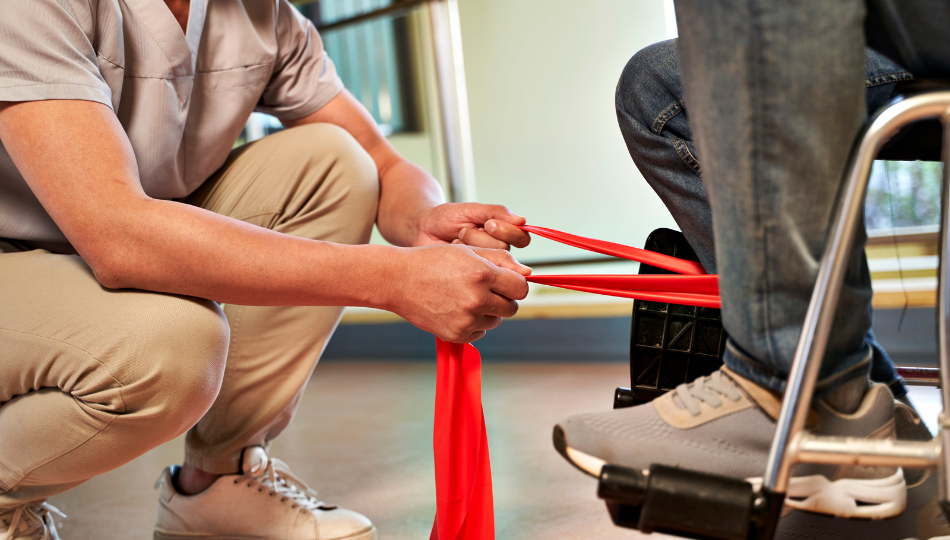By Emily Peters-Tempel, Doctor of Occupational Therapy Candidate, Russell Sage College
Motor and non-motor symptoms impact the daily functioning of individuals with young-onset Parkinson’s (YOPD). Various approaches, including occupational therapy interventions, can manage these symptoms. This post includes preliminary results of the study An Exploration of Functional Impact in Young-Onset Parkinson’s Disease and techniques individuals can use at home to help manage Parkinson’s symptoms.
The study aimed to determine the impact of both motor and non-motor symptoms on daily functioning and quality of life for those living with YOPD. This research includes unpublished data from a Doctor of Occupational Therapy thesis. This information is intended to raise awareness about the daily struggles individuals with YOPD face due to motor and non-motor symptoms.
Data from 213 individuals, the majority of whom were aged 39-59 years and all of whom had been diagnosed with YOPD, were analyzed to determine the impact Parkinson’s had on the respondents. The motor and non-motor symptoms associated with YOPD were found to impact function in cognition, mood, social contexts, and daily tasks—the result of this study aligned with what we have seen elsewhere in the literature. Occupational therapy interventions can be used at home and in the community to manage the symptoms commonly experienced by people living with YOPD.
For example, occupational therapy interventions for cognition, employment, managing emotions, and engaging in social life can be used throughout your daily life. Note that this post contains recommendations for managing motor and non-motor symptoms, and you should confirm with your physician that these recommendations are appropriate for you before changing your behavior.
Cognition and YOPD
Many individuals with YOPD have difficulty finding words, focusing during tasks, articulating what they want to say, and concentrating. Additionally, as cognition declines, so do social engagement and physical abilities. Occupational therapy interventions can optimize cognitive performance and help individuals with YOPD to improve daily functioning, social participation, and physical abilities.
Strategies for Cognition
Attention
- Use a timer to help you stay focused on the task.
- Store items in the same place after each use. Labeling cupboards or drawers may help you when returning items to where they belong.
- Minimize distractions in your space; reduce clutter.
- Complete one task at a time and eliminate excess noise.
- Write out the steps of the task you need to complete and check off items as you complete them.
- Avoid doing two tasks simultaneously when there is a risk you might fall.
Driving
- Store all possible distractions within your trunk.
- Adjust GPS, seats, mirrors, and all controls before driving.
- Power down your devices or store your phone in a location you cannot access.
- Pull over to the side of the road or park somewhere safe to use your phone or engage in any task other than driving.
- Plan to drive familiar routes and avoid highways when possible.
- Avoid driving during rush hour. Use websites or cell phone applications like Waze Navigation to monitor traffic.
- If possible, do not drive when approaching an OFF time.
- Consult with your physician about driving: your doctor may have additional solutions to address your concerns about driving.
Memory
- Keep a daily schedule. Examples of items to include in your daily schedule include times to take your medications, times for chores, social events, due dates for bills, or when you need to complete shopping. View this schedule often.
- Determine a particular day each week for a specific task, such as Monday is laundry day or Sunday is for grocery shopping. A weekly routine can help you avoid missing specific responsibilities.
- Use an address book and keep a list of important phone numbers and relationships in an easily accessible location.
Work and YOPD
Many people living with YOPD feel they cannot maintain their performance at work due to their symptoms and limit their work due to pain and fatigue. This may decrease the quality of life in working-aged individuals. Occupational therapy interventions may help you manage pain, fatigue, and other symptoms to improve your ability to continue working.
Interventions for Work
- Complete work tasks while sitting; sitting will allow you to conserve your energy throughout the day.
- Use computers to your advantage: use voice-to-text options, enable accessibility functions, and use software or hardware utilities that may help to minimize tremor.
- Pace your work responsibilities and spread them throughout the day to allow for rest and recovery.
- Pay attention to your posture at work, even when seated; good posture can help you manage fatigue and general pain. Good body mechanics can help you work through pain and avoid injury. Using tools to help you reach items can help you maintain good body mechanics.
Emotions and YOPD
Anxiety and emotional discomfort can impede your ability to engage in social situations. People living with YOPD may feel they have to appear optimistic in front of others, believe their health will worsen, have anxiety about the future, have difficulty expressing their emotions, and become upset easily. Occupational therapy interventions for these experiences include:
- Relaxation and mindfulness strategies to increase overall well-being
- Strategies for social engagement
- Emotional regulation techniques
Strategies to Enhance Well-being
- Maintain a routine, such as completing your responsibilities in the same order every time and stick to that schedule.
- Incorporate physical activity into your daily schedule and remember that exercising in a social setting is ideal for well-being.
- Keep your windows and blinds open during the day and spend time near or in the sunlight daily.
- Maintain a daily journal and track your stressors, relaxers, and overall mood each day.
- Practice stress management techniques, including progressive muscle relaxation and diaphragmatic breathing.
- Consider working with a mental health professional or social worker.
Social Experiences and YOPD
Some individuals with YOPD may feel like a burden to others due to their need for assistance. They also may sacrifice their own well-being to care for others and notice people treating them differently because they have Parkinson’s. Through mindfulness strategies, occupational therapy interventions can help people with YOPD address self-image, social engagement anxieties, and mental health issues.
Interventions for Social Life
- Maintaining an anxiety journal will allow you to track what social situations elicit anxiety, and you will think about how to work through the situation. Rate your level of anxiety on a scale of 1-10, describe the thoughts and feelings experienced, explain how the anxiety impacted your ability to engage socially, describe what happened right before you felt anxious, and make note of how you reduced your anxiety within the social situation, or what could you do next time to diminish your anxiety.
- A daily or monthly planner can help you plan for upcoming social events. Use your previously used pain and fatigue journals to predict what times of day may work best for social events. Use the journals to remind yourself which activities to avoid before or during your social event to ensure you aren’t experiencing pain or fatigue.
- Practicing facial exercises such as raising eyebrows then frowning, closing eyes shut then opening eyes wide, smiling then puckering lips, opening mouth wide then closing the mouth, and licking your lips can help with facial masking.
Non-Motor Symptoms (Fatigue and Pain)
People living with YOPD often report feeling tired and/or in pain, common non-motor symptoms. Fatigue and pain may make it difficult to complete essential household tasks, and individuals may stay home and limit work when those symptoms get severe. Occupational therapy interventions to manage fatigue and pain may be helpful.
Interventions for Fatigue and Pain
- Maintain a fatigue journal to track times you feel fatigued throughout the day and what activities make you tired. This can help you to plan your days to optimize your energy and productivity.
- Keep a pain journal to document times you feel pain throughout the day and what activities aggravate your pain.
- Avoid staying in one position for over 20 minutes. Moving around can assist with managing pain.
Interventions to Improve Sleep
- Have a regular bedtime routine. Go to sleep at the same time every night and wake up at the same time every day. This will help improve sleep quality.
- Use your bedroom for sleep only. Do not watch TV or use your phone in your bedroom.
- Avoid eating or drinking two hours before sleep to minimize urges to use the bathroom.
- Keep your bedroom cool if possible. Use cooling sheets or light blankets to ensure you do not become too warm during the night.
Motor Symptoms
Individuals with YOPD report motor-related issues that prevent them from being able to move, eat or drink, or take care of themselves in public. Occupational therapy interventions can address many of these issues and, as a result, diminish stigma, increase daily functioning, and promote mental health for individuals with YOPD.
Motor Symptoms (Dressing, Eating/Drinking, Moving)
- Visualize each part of a multi-step movement before you make it. For example, when tying your shoes, visualize bending forward, grasping the shoelaces, bending your elbow, pulling the laces, etc.
- Perform stretching exercises daily to increase your flexibility and help with pain. Perform these exercises while seated or lying down to diminish fatigue and fall risks.
- Incorporate large movements into exercise. Consider joining a boxing club, biking, swimming, etc. Always consult your physician or physical therapist before changing your exercise routine to ensure it is right for you.
- Use a metronome app on your phone or music to minimize freezing when walking. Focus your energy on stepping to the beat and moving with the music or rhythm. Clapping, counting, and tapping can also reduce freezing.
- Keep pathways within your home clear. Eliminate obstructions and tripping hazards like shoes or throw rugs from walking paths.
- Avoid multitasking while moving in your home, especially around stairs.
Interventions to Help with Dressing
- Use adaptive equipment to your advantage! Button hooks, elastic shoelaces, Velcro, long-handled shoehorn, sock aides, and zipper pulls can be used to adapt your dressing routine.
- Get dressed daily in front of a mirror. Watching yourself move can cue you regarding your body position or how to adjust your technique.
- Lie down to get dressed to conserve energy and decrease the risk of falls. Dress your bad side first. When putting pants on lying in bed, thread your legs into the pants, then log roll to each side and hike the pants into place.
- Limit storing your items on the floor or in low drawers. Try to keep items easily accessible or within arm’s reach.
- Do not wear clothing that is so long you might trip on it or with pockets wide enough to catch on doors.
- Sit while getting dressed; put your lower body clothing on first and only stand once to hike up garments. Sitting and limiting standing when dressing conserves energy and limits risks of falls.
Interventions for Preparing Food and Eating
- Use a chair to sit while preparing meals or doing dishes.
- Use large/weighted utensils for eating; use heavy glasses/containers to drink; eat and drink while seated.
- Purchase smaller juice or milk containers; gallons can be heavy and fatiguing.
- Use a pizza slicer to cut soft foods on a cutting board or plate.
- Place a rubber mat or a wet towel under a cutting board or bowl to eliminate sliding and help with control and safety when preparing food.
- Place pots on the counter and slide instead of lifting the pots to move around the kitchen.
- Attend to your posture when you are eating or drinking. Sitting upright with feet planted firmly on the ground is optimal for the muscles needed to swallow and assists with fatigue.
- Carbonated beverages can reduce coughing or aspiration compared to other thin liquids.
Final Thoughts
Within the scope of occupational therapy, interventions may be provided to address cognitive, social, emotional, and physical dysfunction impacting functioning. As the motor and non-motor symptoms of YOPD impact functioning in all areas, occupational therapy may have inestimable value in promoting the function, well-being, and health of individuals living with YOPD.
Acknowledgments, Additional Resources, and References
The student investigator, Emily Peters-Tempel, would like to acknowledge Debra Collette, OTD, OTR/L, Kristi Lamonica, Ph.D., Dayna Maniccia, DrPH, MS, Becky Bernhardt, OTD, OTR/L, CNDT, CAPS Christine Mulligan, OTD, OTR/L, and Wendy Gaughan, OTD, OTR/L for their dedication to this project.
- AAA Roadwise Driver
- Senior Driver Safety & Mobility
- AAA’s Advocacy & Additional Resources
- AAA Center for Driving Safety and Technology
- Tips for Preventing Distracted Driving
- American Occupational Therapy Association: Finding a Driving Specialist
- Driving Safely While Aging Gracefully
- Safe Driving for Older Adults
American Occupational Therapy Association (2020). Occupational therapy practice framework: Domain and process—Fourth edition. American Journal of Occupational Therapy, Vol. 74(Supplement_2), 7412410010p1–7412410010p87. https://doi.org/10.5014/ajot.2020.74S2001
Fleita, M.R., Carter, B., Cutler, M., (2021). Effects of improvisational dance on nonmotor symptoms among people with Parkinson’s disease. American Journal of Occupational Therapy, Vol. 75(Supplement_2), 7512515292p1. https://doi.org/10.5014/ajot.2021.75S2- RP292
Foster, E.R., Bedekar, M., Tickle-Degnen, L., (2014). A systematic review of the effectiveness of occupational therapy-related interventions for people with Parkinson’s disease. American Journal of Occupational Therapy, Vol. 68(1), 39–49. https://doi.org/10.5014/ajot.2014.008706
Gillen, G., & Nilsen, D. (2020). Stroke rehabilitation: A function-based approach (5th ed.). Elsevier.
Hall, C.A. (2018). Occupational therapy toolkit: patient handouts and treatment guidelines (7th ed). Hallen House Publishing.
Leite Silva, A. B. R., Gonçalves de Oliveira, R. W., Diógenes, G. P., de Castro Aguiar, M. F., Sallem, C. C., Lima, M. P. P., de Albuquerque Filho, L. B., Peixoto de Medeiros, S. D., Penido de Mendonça, L. L., de Santiago Filho, P. C., Nones, D. P., da Silva Cardoso, P. M. M., Ribas, M. Z., Galvão, S. L., Gomes, G. F., Bezerra de Menezes, A. R., dos Santos, L., Mororó, V. M., Duarte, F. S., & dos Santos, J. C. C. (2023). Premotor, nonmotor and motor symptoms of Parkinson’s disease: A new clinical state of the art. Ageing Research Reviews, 84, 101834. https://doi.org/10.1016/j.arr.2022.101834
Peters-Tempel, E. (2023). An exploration of functional impact in young-onset Parkinson’s disease. [Unpublished Data]. Russell Sage College
Silva, V. F., Simoes, K. M., Freire, I. D. A., Cardenas, R. N., Gongalvez, L. G. O., Borges, C. J., Militao, A. G., & Valentim-Silva, J. R. (2017). Quality of life, cognitive impairment, treatment, and physical exercise in patients with Parkinson’s disease: A review. Journal of Exercise Physiology Online, 20(5), 98+. https://link.gale.com/apps/doc/A532085045/AONE?u=nysl_ca_sagecoll&sid=bookmark-AONE&xid=54d30916
Sveinbjornsdottir, S. (2016). The clinical symptoms of Parkinson’s disease. Journal of Neurochemistry, 139(Suppl. 1), 318–324. https://doi.org/10.1111/jnc.13691
Meet Emily Peters

Emily Peters is a Doctor of Occupational Therapy student at Russell Sage College in Troy, NY. She first became exposed to neurodegenerative diseases as a home health aide many years ago. That mission to help individuals remain safe and independent in their homes is still a big part of what drives her. She is grateful to the Parkinson’s community for welcoming her and helping her learn alongside them on her road to becoming a clinician.
WANT MORE PRACTICAL ARTICLES LIKE THIS?
You can learn much more about living well with Parkinson’s today through our Every Victory Counts® suite of resources. Each manual is packed with up-to-date information about everything Parkinson’s. Click the link below to reserve your manual(s).
Thank you to our 2023 Peak Partners, Amneal and Kyowa Kirin, and our Every Victory Counts Gold Sponsor, AbbVie Grants, for their ongoing support of these must-have manuals. Additionally, we’d like to thank Barbara and Dale Ankenman, Abby and Ken Dawkins, Bonnie Gibbons, Gail Gitin in loving memory of Gene Gitin, Irwin Narter, and Lorraine and J Wilson for their generous donations that allow us to make these resources available and free to all.

















